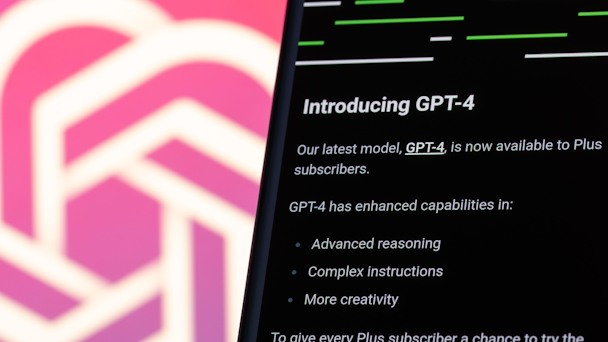Here’s what marketers need to know about GPT-4
OpenAI’s new large language model was released earlier this week, amid much fanfare. Below, we highlight some key points that marketers should bear in mind about GPT-4.

GPT-4 is currently available to paid subscribers of ChatGPT+ or via Microsoft Bing. / Adobe Stock
On Tuesday, San Francisco-based tech startup OpenAI announced the release of GPT-4, the latest iteration of the large language model (LLM) that powers the company’s popular ChatGPT chatbot. The announcement was met with much media fanfare - which is unsurprising, given the deluge of press that has celebrated (and in some cases lamented) the capabilities of ChatGPT since its November 2022 release.
What sets GPT-4 apart from its predecessor, GPT-3.5? How could it impact the day-to-day lives of marketers?
Here are some important points that marketers should understand about the new technology and its implications:
GPT-4 is currently available to paid users of ChatGPT+, the chatbot’s premium subscription offering. OpenAI has opened up a waitlist for developers who want to use the model's API.
Advertisement
Whereas the original ChatGPT could respond only to text prompts, GPT-4 is also capable of responding to images. A report from The New York Times, which included a snapshot of a conversation with GPT-4, showed that the new LLM could suggest simple recipes – complete with clear preparation instructions – based on a photograph of a few food items sitting on a shelf inside of a refrigerator. Another demonstration on OpenAI’s website showed GPT-4 responding to an image of eggs, flour, milk and what appears to be a bowl of whipping cream, along with the prompt: “What can I make with these ingredients?” The chatbot responded with a list of potential culinary creations - among them pancakes, French toast and quiche – and some chipper words of encouragement: “These are just a few examples, but the possibilities are endless!”
Advertisement
GPT-4 is much more knowledgeable across a much broader set of domains than its predecessor. A few examples: it can reason more abstractly; it can generate more contextualized and detailed text responses; and it can come up with its own simple (and not entirely unfunny) jokes. It also has a particular knack for test-taking. According to OpenAI, GPT-4 scored in the 99th percentile of the Biology Olympiad (an international biology exam for pre-university students), whereas ChatGPT scored in the 31st percentile.
If high school teachers and university professors were worried about students cheating by using ChatGPT, their concerns are likely to become even more acute as GPT-4 becomes broadly available.
“Technology improves exponentially, not in a linear fashion,” says Jim Lecinski, associate professor of marketing at Northwestern University’s Kellogg School of Management, and co-author of The AI Marketing Canvas: A Five-Stage Road Map to Implementing Artificial Intelligence in Marketing.
“For everyone who was dismissing [AI-powered chatbots] over the past few months because they didn’t phrase a response as perfectly or eloquently as a human would have – well, here we are; those criticisms and reasons not to use AI in your marketing toolkit have now largely been addressed.
“GPT4 is far from perfect. But it illustrates how major improvements are now coming at a more and more rapid pace – that's the ‘exponentially’ part,” he adds.
Suggested newsletters for you
To Lecinski's point, GPT-4 is not infallible. It’s still prone to what AI researchers commonly call ‘hallucination’ – a tendency to provide factually erroneous information with misleading and potentially dangerous certitude, or otherwise behave in a manner that’s apparently contrary to its training protocol.
We’ve already seen some of the consequences of such hallucinations play out in the big tech world. Google’s Bard – an AI chatbot released last month – recently generated an inaccurate statement about the James Webb Space Telescope during its first public demo, costing Google’s parent company Alphabet at least $100bn in market value.
Shortly after that, Microsoft’s newly revamped AI-powered Bing – which, as it turns out, has been operating on GPT-4 all along – tried to convince New York Times correspondent Kevin Roose to leave his wife, among other unsettling behavior. (Microsoft’s GPT-4-powered Bing is now available for use sans waitlist).
GPT-4 is not totally immune to hallucination. But OpenAI claims that it represents an improvement compared to its predecessor: “We spent 6 months making GPT-4 safer and more aligned,” the company wrote on its website. “GPT-4 is 82% less likely to respond to requests for disallowed content and 40% more likely to produce factual responses than GPT-3.5 on our internal evaluations.”
It’s easy to feel overwhelmed by the sudden pace of technological change. In order to keep up, Lecinski recommends broadening one’s perspective: “Marketers must be focused on the big picture, and not get lost in these specific technical improvements now happening every week,” he says. “The organizations that have a plan and are implementing [AI] are seeing actual tangible gains … The stunning capabilities of GPT-4 make it clear that marketers can no longer wait and wonder. Now is the time to be formulating and implementing your plan to use AI in marketing.”
For more on the latest happening in AI, web3 and other cutting-edge technologies, sign up for The Emerging Tech Briefing newsletter here.

